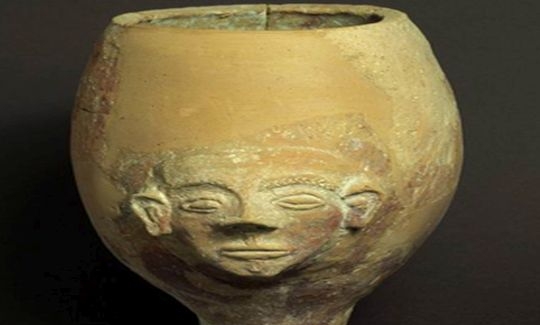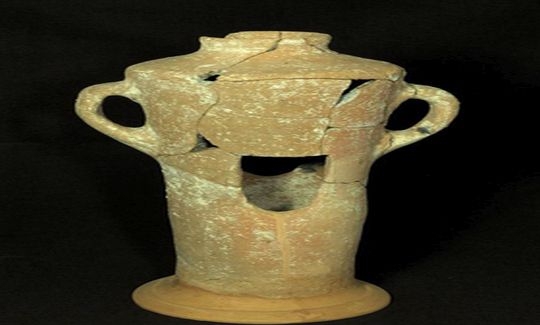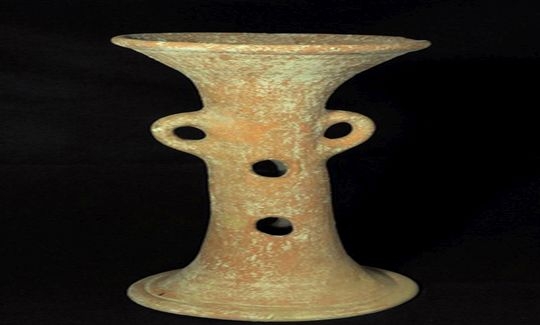Treasure of Cultic Vessels -
Tel Qashish
Saturday, 25.08.12
Sunday, 08.12.13
:
Avshalom Zemer
More info:
04-6030800For the first time, a favissa (repository for discarded cult objects), dated to the 13th century BCE, has been discovered some 300 m. north of Tel Qashish and about 2 km north of Tel Yokneam. It contained intact vessels which had elsewhere only been found as shards.
Tel Qashish lies on the northern bank of the River Kishon, on the slopes of Kiryat Haroshet and extends over some 10 dunams. Professor Yohanan Aharoni identified the Tel as 'Helkath', which appears in the register of towns in Eretz-Israel conquered by Pharaoh Thutmose III (1479-1425 BCE). The Tel Qashish excavation team, headed by Professor Amnon Ben-Tor of the Hebrew University in Jerusalem, indicated that it could be identified with 'Dabbasheth', which appears in the definition of the boundaries of the tribe of Zebulun: "And the third lot came up for the children of Zebulun...And the border of their inheritance was unto Sarid. And their border went up toward the sea, and Maralah, and reached unto Dabbasheth ..." (Joshua 19, 10-11).
The Tel was excavated in 1978-1987 under the auspices of the Archaeology Department of the Hebrew University and the Israel Exploration Society. Fifteen strata of settlements were identified, from the Early Canaanite Age I (3600-3000 BCE) to the Persian period (539-332 BCE). There were also some pottery shards from the Neolithic (9500-6400 BCE) and Chalcolithic (6400-3600 BCE) eras, from the Hellenistic era (332-37 BCE), from the Early Islamic Period (638-1187 CE), the Mameluke Period (1250-1516 CE) and the Ottoman Period (1516-1917 CE).
In the salvage excavations of 2010, directed by Uzi Ad and Edwin C. M. van den Brink with Orit Segal of the Israel Antiquities Authority, during the laying of a gas pipeline to the industrial area of Haifa Bay, a trove of pottery vessels was discovered to the north of the Tel, dated to the Late Canaanite Age IIB (1300-1200 BCE). The vessels were stored in a pit in the limestone rock, of which the ceiling had collapsed in ancient times. The pit is elliptic, 3x1.5 m. wide, and 3 m. deep. It contained more than 200 items, including rare typologies that were previously unknown. Some of the items were locally made, others were of Mycenaean origin and from Cyprus. Among the local products were tall cylindrical stands, small stands, incense-burners, and chalices for libation, for burning oil, and/or for incense. Among other locally produced items are goblets (on one of which a man's face is moulded), bowls, jugs, juglets, cooking pots, oil lamps, a Canaanite jar and 'cup-and-saucer' vessels. Items imported from Cyprus include bowls of White-Slip and Base-Ring wares, as well as White Shaved juglets. Among the items from Greece are stirrup-jars, an amphoriskos, and flasks, all of them from the Mycenaean IIIB group.
There is also a faience bowl, apparently from the Syrian-Canaanite region. (Faience is a compound with a crystalline base, usually quartz, mixed with a glassy alkaline substance).
Based on the stands, the incense-burners, the chalices and the goblet with a man's face, researchers suggest that the contents of the trove appertained to a small local temple (which has not yet been found), and consisted of items brought by worshippers as offerings. The findings are not representative of any specific deity, nor do they indicate the identity of the worshippers. The pottery was either buried in haste for fear of damage by enemy forces, or stored in the pit when there was no more room elsewhere, or discarded.
The imported vessels in the favissa are evidence of the strong maritime connections of the Late Canaanite era, especially between Eretz-Israel, the island of Cyprus, and the Aegean. Evidence of such trading is supported by the shipwreck at Uluburun (9 km. south-east of Kas in southern Turkey), dated to ca. 1300 BCE, and the wreck off Cape Gelidonya, near Bodrum in south-west Turkey, dated to ca. 1200 BCE.
Dating of the favissa to the 13th century BCE relies on parallels among the various pottery vessels, and on a stirrup-jar resembling the one found in the favissa that was discovered in an excavation at Gurob in the Fayum district of Egypt, and contained a scarab from the reign of Pharaoh Ramesses II (1279-1213 BCE).
The exhibition is presented at the National Maritime Museum by courtesy of the Israel Antiquities Authority.



